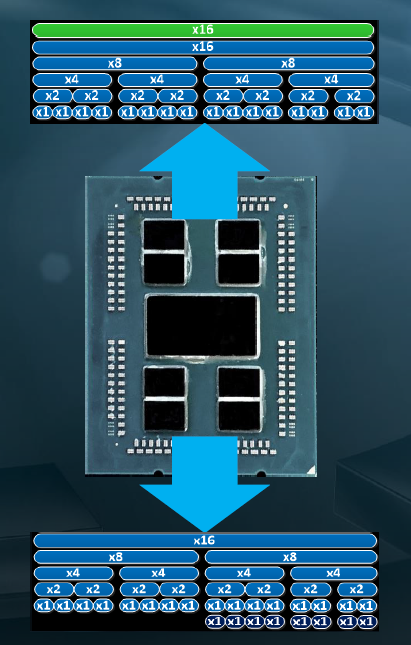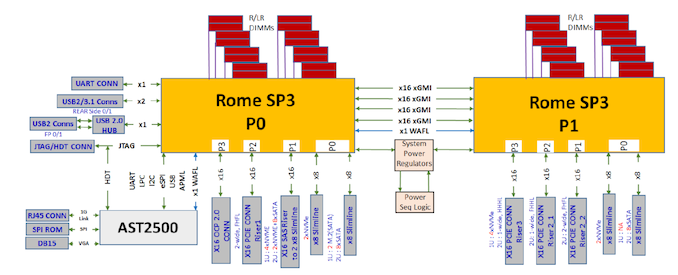AMD Rome Second Generation EPYC Review: 2x 64-core Benchmarked
by Johan De Gelas on August 7, 2019 7:00 PM ESTPCIe 4.0
As the first commerical x86 server CPU supporting PCIe 4.0, the I/O capabilities of second generation EPYC servers are top of the class. One PCIe 4.0 x16 offers up to 32 GB/s in both direction, so each socket offers up to 256 GB/s in both directions, for a full 128 PCIe 4.0 lanes per CPU.
Each CPU has 8 x16 PCIe 4.0 links available which can be split up among up to 8 devices per PCIe root, as shown above. There is also full PCIe peer-to-peer support both within a single socket and across sockets.
With the previous generation, in order to enable a dual socket configuration, 64 PCIe lanes from each CPU were used to link them together. For EPYC, AMD still allows for 64 PCIe lanes to be used, but these are PCIe 4.0 lanes now. There is also another feature that AMD has here - socket-to-socket IF link bandwidth management - which allows OEM partners to design dual-socket systems with less socket-to-socket bandwidth and more PCIe lanes if needed.
We also learned that there are in fact 129 PCIe 4.0 lanes on each CPU. On each CPU there is one extra PCIe lane for the BMC (the chip that controls the server). Considering we are living in the age of AI acceleration, the EPYC 7002 servers will be great as hosts for quite a few GPUs or TPUs. Density has never looked so fun.












180 Comments
View All Comments
MDD1963 - Friday, August 9, 2019 - link
of the '1800 servers', how many of those are virtual, just out of curiosity? ('1800 servers' is not quite as impressive if there were, for example, 10 hosts w/ 180 Windows VMs each, for example) U.S.A.F offices are still mostly Windows 10...I'd suspect the are datacenters at each base having a large Windows Server presence as well.. (But, we used Redhat onboard assorted recce aircraft for many years now....; which seems stupid in light of the fact they could easily use CentOS for free; presumably, a Senator's family members work at Redhat, and enjoy the large income from support contracts)eek2121 - Friday, August 9, 2019 - link
Employers use Windows, data centers use Linux. All the major cloud providers, including Microsoft, have reported that Linux has the highest market share.gylgamesh - Friday, August 9, 2019 - link
Could you please specify what kind of servers those are and what tasks do they perform, and also which MS Windows OS are they using? Thanks.Slickest - Thursday, August 8, 2019 - link
I work for one of the largest colleges in the nation, and 90% of our servers are Windows.69369369 - Thursday, August 8, 2019 - link
"LUL"Go back to Twitch kiddo.
azfacea - Thursday, August 8, 2019 - link
and what would u do if i dont?Oliseo - Thursday, August 8, 2019 - link
Tell your mum you're up late again and she will force you to go outside, and we all know how much your dislike having to do that.prophet001 - Monday, August 12, 2019 - link
I don't get the hate for windows server? How you gonna run a domain and active directory in linux?CaedenV - Wednesday, August 21, 2019 - link
I use to work in schools, and a few that could not afford Windows Server would run AD through some Linux application. It was not exactly full-featured, but it worked well enough for 'free' solution.deltaFx2 - Wednesday, August 7, 2019 - link
@Pancakes: Are you kidding? 1T perf is at par with Skylake. Windows licenses per core. Why would anyone buy a SKU with more cores than they need? And if they did do that, why would they not run them on a VM? Do these people also buy more racks than they need and run windows just for the fun of it?